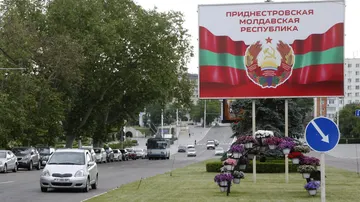Every so often, Transnistria returns to the spotlight. For many, absolutely unknown, this region located geographically within Moldova has little or nothing to do with the Moldovan Government. In recent days, the Parliament of this separatist region, openly pro-Russian, has asked Vladimir Putin’s Russia protection, while the United States waits vigilantly for Moscow’s possible actions. The tense situation in the region is not new, although tensions have been increasing since the beginning of the conflict between Russia and Ukraine. Moldova’s determination to integrate into the European Union is another of the factors that has ‘removed’ in this region.
With just over 4,100 square kilometers and around half a million inhabitants, the Pridnestrovian Moldavian Republic, the official name of the region, is located very close to Ukrainian territory. And although it is located on the map of Moldova, the region functions as an independent country, with its own presidential government. Its president is Vadim Krasnoselski; the capital of the territory, Tiraspol. However, only two territories recognize the independence of Transnistria as such, and they are not even full-fledged States: South Ossetia and Abkhazia, both pro-Russian territories. Let’s go by parts.
Is Transnistria an independent country?
To answer this question you have to go back a few years. In the 1920s, the USSR established the Moldavian Autonomous Soviet Socialist Republic in a mainly Russian-speaking territory but also with a part of Ukraine and a region that had been part of Romania. In the last years of the USSR, the multicultural population of the region of Transnistria unilaterally established itself as a Soviet republic, while in the face of the fall and dissolution of the Union, Moldova declared its independence, like most of the post-Soviet states.
Despite its self-proclaimed independence, Transnistria is not recognized by any sovereign country.
And it was from there when facing the rise of Moldovan nationalism, this region responded with a conflict that ended in open war, as explained by historian William Zadeskey, from Ohio State University (United States). In July 1992 a ceasefire was signed “that ensured the de facto independence of Transnistria and created the peaceful, though endless, frozen conflict between Tiraspol and Chisinau.”, Explain. Since then, Russia has maintained the support it already transferred to the region in the 1950s, increasing Russian nationalism in this territory.
In 2006, Parliament called a referendum on the status of Transnistria’s independence, which included future integration into Russia. With a turnout of more than 78%, 96% of voters chose not to give up independence and integration in Moldova, while 98% were in favor of integrating into Russia, as the Ukrainian territory of Crimea did in 2014. Even so, no country recognizes Transnistria as a sovereign state; only the disputed territories (pro-Russian, too) of Abkhazia and South Ossetia do so.

Tiraspol, capital of the pro-Russian Moldovan separatist region of Transnistria | Europa Press/Contact/Jerzy Dabrowski
Who then rules in Transnistria?
Despite this, Transnistria holds its own elections and has its own government. Its president is Vadim Krasnoselsky, born in the USSR, former Minister of the Interior of the territory. In 2016 he was the winner of the elections in Transnistria, against Yevgeny Shevchuk, with 61% of the votes; He revalidated the position in the 2021 elections, with 87% of the electorate’s support.
Transnistria not only has its own Government. It has its own Army and its own currency —the Transnistrian ruble—, in addition to his own passport since 2001 which, however, is not valid in practically any other country. However, Transnistria allows dual nationality, so to travel abroad, the population can do so with their Russian, Moldovan, Ukrainian or Romanian nationality.
What does Russia want from Transnistria?
Krasnoselsky has never hidden his intention that Transnistria integrates into Russia. It is the natural “destiny” of the region, he says. In this Moldovan region, Victory Day parades are held as they do in any area of the Russian Federation, with the aim of highlighting the historical links between the two regions. But what is Russia looking for from this small region on Moldovan soil?
As explained by CNN, if the Russian invasion of Ukraine had gone as planned, they would have managed to take control of Kyiv, the capital, and the rest of the country. The commander of the Russian Central Military Region, Rustam Minnekaev, assured at the time that one of the objectives of the Russian “special operation” on Ukrainian territory was to create a kind of corridor in southern Ukraine to Transnistria, but Kyiv managed to stop the advance in the Kherson area, about 350 kilometers from this region. “The Kremlin seeks to use Transnistria as a proxy controlled by Russia, which it can use to derail Moldova’s accession process to the European Union“, according to a report from the Institute for the Study of War collected by CNN.
The weapons of Transnistria
In this region is one of the Europe’s largest weapons arsenals, capable of generating a detonation equivalent to the Hiroshima bomb, according to some experts. This is the Cobasna deposit, located on the border with Ukraine, originally created in the 1940s in the then Soviet Moldova and to which only the Russian and Transnistrian authorities have access. It is believed that it may contain up to 20,000 tons of Soviet-era weapons and is guarded by about 1,500 Russian soldiers.
From the Czech environmental NGO Arnika, they report that more than half of the arsenal is obsolete, so it cannot be used or transported, which is why they warn of the risk of “a possible explosion of these deposits” that “would cause a huge disaster.” ecological and human”.
Source: Lasexta
Ricardo is a renowned author and journalist, known for his exceptional writing on top-news stories. He currently works as a writer at the 247 News Agency, where he is known for his ability to deliver breaking news and insightful analysis on the most pressing issues of the day.












